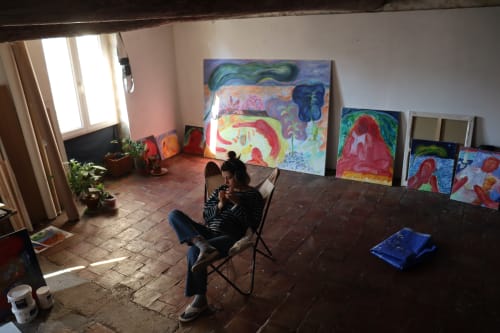How are you feeling after the opening of your new show? I'm feeling good! Times before openings are high on energy and it always takes a while to start thinking about something else when all is wrapped up, but now I can see new desires starting to shape up and that feels nice.
What is the significance of the show's title 'Night Emails to Friends'? This title came up because the paintings reminded me of the content of night emails you send to friends. It is not because they are private or particularly intimate, but because they represent rooms for wandering, they contain elements that might not mean so much at first, or at all sometimes. They hold space for doubt(s), for getting a little lost, they try something. Exactly what night emails to friends are for. As often with my titles, it is more about giving information on the context and environment of the making, rather than describing precisely what there is to see.
In your last show at the gallery, your paintings centered on interior scenes and seemed to have a more introspective focus. In these new paintings, you have moved your motifs to exterior spaces, included larger groups as well as employing a more saturated palette. How do you experience this apparent shift? I think all these transformations belong to an unconscious, but desired phenomenon. Where I am painting is an important element in my practice, I cannot dissociate the works from the environment they have been made in, so a change of settings always has an impact on them. To prepare this exhibition, I decided to go paint somewhere else, so I shared my time between my grandmother's house in the countryside on top of a hill overlooking a traditional Provencal village and Marseille, city of contrasts, always loud where nothing is bland. Painting exterior spaces came naturally and without noticing it really, I became very interested in it and could let go of the character element on some occasions. I lived in my studio during the whole preparation of the exhibition, so the outdoors became an escape space, while usually I associate this feeling to the studio.
You are originally from Marseille but have completed your MFA at the Danish Royal Academy of Art and have been living in Denmark over the past 8 years. How did being back in Marseille for 9 months influence your process and the paintings included in the show? I left Copenhagen in the summer with a clear idea of what the exhibition would look like and be about, and I ended up, with no surprise, with a very different result. I need situations and environments to work on me in order to make work that I think is interesting to do. It can feel like a precarious and stressful process, but it is a process I am learning to accept and use positively. Preparing the exhibition in a different place was intentional, and what I thought was going to be a smooth and obvious transition, happened not to be so natural after all. I was at the same time in a zone of comfort and not, I spoke my mother tongue, but I lost my accent, and I think that's what we can also experience in the paintings, the permanent ambivalence. Characters are melting into their environment, but they seem to be crushed by it too, for example in The Private Life of Paintings (2022-2023) and Long Timing (2023).
Are there any references or inspirations that were particularly significant to this body of work? Always a lot! For this exhibition I put extra effort in being aware of the material I surrounded myself with, I tried to be precise and active about the images that were going to influence me while painting. References are always a mix of different things, this time I have in mind my grandfather's paintings left in the house, the Mediterranean sea, looking at Modigliani more and more, paintings by Constantin Nitsche at La Traverse, my friend Martin Gallone's photographs, Picasso's series of etchings 'La suite Vollard', never getting tired of Bonnard, David Medalla, birdwatching the parakeets in the city, Munch's series 'Melancholia', etc.
You often reference the idea of being in doubt as central to your painterly practice, how do you think these feelings manifest themselves in your paintings? There are many angles of doubt that interest me. Right now, I think of the painting Keeping Mistakes and the Fear of Painting (2022-2023). It is somehow built on mistakes. I kept the lines that led me to the finished work. Even if I make a quick sketch before starting a painting, I never follow my own guidelines and end up figuring out the painting while painting it. Instead of "covering" my tracks, in this work I wanted to keep and accept the hesitations, accept to change my mind, deal with failures and all the doubt(s) that occurred. I think it has something to do with keeping in mind that everything is open to transformation as well. A different angle of doubt could be seen in the painting Finding Groups of Safety (2022), where we can see a character completely surrounded by the sea but still listening into a shell to the sound of it. Double-checking reality- or even ourselves, how we feel and what we feel- kind of thing. To doubt also gives the possibility to open up to new territories of thoughts, we can question deeper and ask different questions. To doubt not to start over but re-adjusting thoughts. Helps us grow.
April 12, 2023


